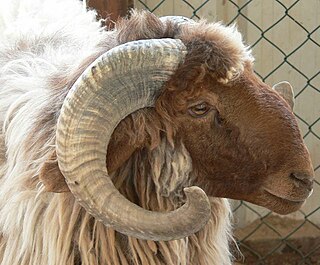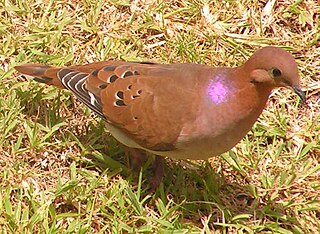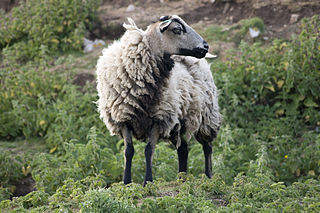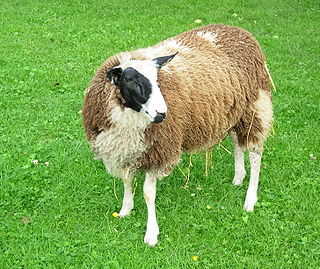Related Research Articles

The Soay sheep is a breed of domestic sheep descended from a population of feral sheep on the 100-hectare (250-acre) island of Soay in the St Kilda Archipelago, about 65 kilometres (40 mi) from the Western Isles of Scotland. It is one of the Northern European short-tailed sheep breeds.

The Cotswold is a British breed of domestic sheep. It originates in, and is named for, the Cotswold hills of the southern midlands of England. It is a large long-woollen sheep, and is kept as a dual-purpose breed, providing both meat and wool.

The Navajo-Churro, or Churro for short, is a breed of domestic sheep originating with the Spanish Churra sheep obtained by the Diné around the 16th century during the Spanish Conquest. Its wool consists of a protective topcoat and soft undercoat. Some rams have four fully developed horns, a trait shared with few other breeds in the world. The breed is highly resistant to disease. Ewes often birth twins, and they have good mothering instincts. This breed is raised primarily for wool, although some also eat their meat.

The Jacob is a British breed of domestic sheep. It combines two characteristics unusual in sheep: it is piebald—dark-coloured with areas of white wool—and it is often polycerate or multi-horned. It most commonly has four horns. The origin of the breed is not known; broken-coloured polycerate sheep were present in England by the middle of the seventeenth century, and were widespread a century later. A breed society was formed in 1969, and a flock book was published from 1972.

The Awassi is a local fat-tailed sheep breed in South-West Asia originated in the Syro-Arabian desert. Other local names can also be Arab, Baladi, Deiri, Syrian, Ausi, Nuami, Gezirieh, or Ivesi (Turkish). It is multi coloured: white with brown head and legs. The ears are long and drooping.

The Barbados Black Belly is a breed of domestic sheep from the Caribbean island of Barbados. It is raised primarily for meat. Unlike most tropical sheep, it is highly prolific, with an average litter size of approximately 2.

The Rambouillet is a breed of sheep in the genus Ovis. It is also known as the Rambouillet Merino or the French Merino. The development of the Rambouillet breed started in 1786, when Louis XVI purchased over 300 Spanish Merinos from his cousin Charles III of Spain. The flock was subsequently developed on an experimental royal farm, the Bergerie royale built during the reign of Louis XVI, at his request, on his domain of Rambouillet, 50 km southwest of Paris, which Louis XVI had purchased in December 1783 from his cousin Louis Jean Marie de Bourbon, Duke of Penthièvre. The flock was raised exclusively at the Bergerie, with no sheep being sold for several years, well into the 19th century.

The fauna of Barbados comprises all the animal species inhabiting the island of Barbados and its surrounding waters. Barbados has less biodiversity than the other Antilles. Human activities are responsible for the change in the composition of the fauna, in particular, the replacement of native species. Species that are able to adapt to human presence have survived.

The Shetland is a small, wool-producing breed of sheep originating in the Shetland Isles, Scotland, but is now also kept in many other parts of the world. It is part of the Northern European short-tailed sheep group, and it is closely related to the extinct Scottish Dunface. Shetlands are classified as a landrace or "unimproved" breed. This breed is kept for its very fine wool, for meat, and for conservation grazing.

Welsh Mountain sheep are small, hardy sheep from the higher parts of the Welsh mountains. The males have horns, and the females are polled (hornless); they have no wool on the face or legs, and they have long tails. There are a number of varieties, bred for sheep farming in Wales. These are mainly colour variations, but some are being developed as separate breeds.
The California Red is a breed of domestic sheep developed in the United States.

The Pelibüey or Spanish: Cubano Rojo is a Cuban breed of domestic sheep. It is found principally in Cuba, where it is the most numerous breed of sheep, but is also reared elsewhere in the Caribbean and in some coastal parts of Mexico. It is a hair sheep – its coat is of hair, not wool; this is a common adaptation to tropical environments. It is likely that it derives at least in part from African breeds of sheep such as the West African Dwarf, and probable that it is related to other American breeds of African origin such as the Barbados Black Belly, the Roja Africana of Venezuela and the Oveja Africana of Colombia.

Sheep or domestic sheep are a domesticated, ruminant mammal typically kept as livestock. Although the term sheep can apply to other species in the genus Ovis, in everyday usage it almost always refers to domesticated sheep. Like all ruminants, sheep are members of the order Artiodactyla, the even-toed ungulates. Numbering a little over one billion, domestic sheep are also the most numerous species of sheep. An adult female is referred to as a ewe, an intact male as a ram, occasionally a tup, a castrated male as a wether, and a young sheep as a lamb.

The Badger Face Welsh Mountain is a distinct variety of the Welsh Mountain breed of domestic sheep bred for sheep farming in Wales. It is a hardy upland breed known for producing a high percentage of twins and triplets under good conditions. It appears in two sub-varieties of its own: the Torddu, which has a white fleece with dark face and belly, and the Torwen, which has a black body with a white belly and white stripes over the eyes. The Torddu is the more common of the two types. In both types, ewes are polled and rams are horned. Although this breed grows wool, it is primarily raised for meat.

The Old Forge Farm, also known as Surveyor's Last Shift, is a historic home located at Hagerstown, Washington County, Maryland, United States. It is a two-story, three bay fieldstone dwelling built in 1762, with a long, two-story, five bay addition. The house features a slate roof. Also on the property are a stone end barn and stone shed, and a stone tenant house.
The West African Dwarf or Djallonké is an African breed or group of breeds of domestic sheep. It is the dominant breed of West and Central Africa. This breed is primarily raised for meat. The Cameroon or Cameroon Dwarf is a breed within this group.
The Bovec is a breed of domestic sheep from the upper valley of the Soča or Isonzo river, now in Slovenia. The breed is named in both Slovenian and in Italian for the town of Bovec or Plezzo; in the Trenta valley it may also be called Trentarka. It is raised in the Soča valley in Slovenia, in the areas of Resia and Tarvisio in Friuli in Italy, and in Styria and Carinthia in Austria. The breed is raised for milk and for meat.

The Cameroon or Cameroon Dwarf is a Cameroonian breed of domestic sheep. It belongs to the West African Dwarf group of breeds. Some have been exported to Europe.

Calico sheep is a type of sheep that has more than one colour within its coat. The colouring is due to a piebald mutation, but the calico sheep is not a recognized breed.